
What is Manual Lymphatic Drainage Massage?
Manual lymphatic drainage massage offers a refreshing approach to rejuvenating your body and mind. This unique massage technique targets the lymphatic system, a complex network of vessels that plays a vital role in eliminating waste and boosting immunity.
If you’ve been feeling sluggish, puffy, or just needing a pick-me-up, this massage could be the solution you’ve been seeking.
But what exactly is manual lymphatic drainage, and how does it work its magic? Join us as we explore the world of this specialized massage, unraveling the intricate workings of the lymphatic system and understanding the precise techniques employed by skilled practitioners. We’ll dive into the potential benefits, from reducing swelling and discomfort to enhancing overall detoxification and well-being.
Of course, the discussion would only be complete by addressing any potential risks or precautions. While generally considered safe, we’ll shed light on the situations where caution should be exercised, ensuring you have a well-rounded understanding of this therapeutic massage.
If you’ve been searching for a natural way to refresh your body and revitalize your spirit, manual lymphatic drainage massage might be the answer you’ve been seeking. Unlock the secrets of this age-old practice and discover how it could be the missing piece to your wellness puzzle.
What Is A Lymphatic Drainage Massage Used For?
Manual lymphatic drainage massage is a unique and gentle approach that targets the lymphatic system, a network of vessels responsible for eliminating waste and toxins from our bodies. This specialized massage technique has become increasingly popular among those seeking relief from various ailments and a boost in overall well-being.
One of the primary reasons individuals seek manual lymphatic drainage massage is to alleviate swelling or edema. This massage can work wonders in reducing puffiness and discomfort, whether it’s due to a condition like lymphedema, where excess fluid accumulates in the tissues, or post-surgical swelling. Its gentle yet effective strokes encourage the proper flow of lymphatic fluid, alleviating buildup and promoting a sense of lightness.
Beyond swelling, manual lymphatic drainage massage has also shown promise in managing inflammation and fluid accumulation pain. The soothing strokes can help alleviate discomfort, providing a respite for those with chronic or acute pain conditions.
However, the benefits of this massage extend beyond physical relief. Many seek it out to promote relaxation and enhance overall well-being. The gentle, rhythmic motions can induce a state of calm, allowing the mind and body to unwind and recharge.
Importantly, manual lymphatic drainage massage may also play a role in supporting the immune system. A well-functioning lymphatic system is crucial for adequately circulating immune cells throughout the body, and this massage can aid in maintaining that vital flow.
While the potential benefits are numerous, consulting with a healthcare professional is always advisable, especially if you have any underlying health concerns. With their guidance and the skilled hands of a trained practitioner, manual lymphatic drainage massage could be the key to unlocking a renewed sense of well-being.

Do Lymphatic Drainage Massages Work?
Yes, lymphatic drainage massages are generally considered adequate, but the degree of effectiveness can vary depending on individual factors and the specific condition being addressed. Here’s a closer look at the supporting evidence:
Management Of Lymphedema
Several studies have shown that lymphatic drainage massage can effectively reduce swelling and improve symptoms associated with lymphedema, a condition characterized by excessive fluid accumulation in the body’s tissues. The massage helps stimulate the lymphatic system, promoting the drainage of excess lymph fluid.
Post-Surgical Recovery
Lymphatic drainage massage has been found beneficial in reducing swelling, bruising, and inflammation after surgeries, particularly those involving lymph node removal or disruption of the lymphatic system. It can aid recovery by facilitating the removal of excess fluid and waste products.
Chronic Conditions
While more research is needed, some studies suggest that lymphatic drainage massage may help alleviate symptoms associated with certain chronic conditions, such as fibromyalgia, chronic fatigue syndrome, and chronic venous insufficiency. The massage may improve lymphatic circulation and reduce inflammation, relieving symptoms.
Relaxation And Well-Being
Many individuals report feeling more relaxed and experiencing improved overall well-being after receiving lymphatic drainage massage. The gentle, rhythmic strokes can promote a sense of calmness and stress relief.
However, it’s important to note that the effectiveness can be influenced by factors such as the practitioner’s skill and experience, the specific massage techniques used, and the individual’s underlying health condition.
Additionally, lymphatic drainage massage should be considered a complementary therapy and should not replace conventional medical treatments prescribed by healthcare professionals.
How Does The Lymphatic System Work In The Human Body?
The lymphatic system is a vital network of tissues and organs that plays a crucial role in the body’s immune defense and fluid regulation. Here’s an overview of how this remarkable system works in the human body:
Fluid Collection
The lymphatic system begins with a network of tiny vessels called lymphatic capillaries that are present in almost every tissue of the body. These capillaries collect excess fluid, proteins, and waste products from the spaces between cells and tissues.
Lymph Formation
The fluid collected by the lymphatic capillaries is called lymph. Lymph is a clear, protein-rich fluid containing white blood cells, particularly lymphocytes, essential for immune function.
Lymph Vessel Network
The lymph fluid is then transported through a complex network of larger lymphatic vessels, similar to veins in the circulatory system. These vessels have one-way valves that prevent backflow and ensure lymph flows in the correct direction.
Lymph Node Filtration
As the lymph fluid travels through the lymphatic vessels, it passes through small, bean-shaped structures called lymph nodes. These nodes act as filters, trapping and destroying harmful substances like bacteria, viruses, and cancer cells. Lymph nodes also house lymphocytes, which play a crucial role in the immune response.
Lymph Circulation
After passing through the lymph nodes, the lymph fluid continues its journey, eventually reaching larger vessels called lymphatic ducts. These ducts drain the lymph fluid back into the bloodstream, primarily via the subclavian veins near the base of the neck.
Fluid Balance
The lymphatic system helps maintain fluid balance by removing excess fluid and returning it to the bloodstream. This process helps prevent swelling and ensures proper nutrient and waste exchange between cells and tissues.
Immune Function
The lymphatic system is an integral part of the body’s immune defense. Lymphocytes, produced in lymph nodes and other lymphatic tissues, identify and attack foreign invaders, such as viruses, bacteria, and abnormal cells, helping protect the body from infection and disease.
The lymphatic system’s efficient fluid regulation and immune surveillance make it essential to overall health and well-being. Disruptions or blockages in this system can lead to various health issues, including lymphedema (swelling), impaired immune function, and increased susceptibility to infections.

Procedures Of Lymphatic Drainage Massage
Unlike a deep tissue massage, where therapists go deep into your muscles, a lymphatic drainage massage is all about gentle encouragement. Here’s what to expect during a session:
- Chill Vibes: Get ready for a calming atmosphere with soothing music to set the mood. You’ll wear loose clothing or comfy under a sheet, ensuring the areas the therapist needs to reach are accessible.
- Talking it Through: The therapist will discuss your health and any areas that might bother you. They’ll also explain the whole process and ensure it fits you well.
- Light as a Feather: The massage uses light pressure, almost like feather-like strokes. The therapist will follow specific patterns that mimic the natural flow of lymph fluid toward your lymph nodes. Think of it as gently guiding the fluid in the right direction.
- Skin on the Move: Sometimes, the therapist might use gentle stretching techniques to help the lymph fluid move along.
- Prime Locations: The massage will likely focus on areas where your lymph nodes hang out, like your neck, armpits, groin, and abdomen. These are the spots where the filtering magic happens!
- Post-Massage Chill: After the massage, you’ll have time to relax and let your body adjust to the stimulation. Drinking plenty of water is also recommended to help your body flush things out even more.
- More Than One Session: Therapists often recommend multiple sessions spaced a few days apart for the best results. This gives your body time to adjust and keeps the lymph fluid flowing smoothly.
Benefits Of Manual Lymphatic Drainage Massage
Feeling like a puffy marshmallow? Manual lymphatic drainage massage (MLD) might be your secret weapon! This massage technique isn’t your typical deep tissue beatdown. Instead, it uses super light pressure to nudge your lymphatic system, the body’s built-in drainage crew, to move things along. Here’s what this gentle nudge might do for you:
- De-puffing Power: MLD can be a lifesaver for folks with swelling, especially those with lymphedema (fluid buildup due to a lymphatic issue). It can also help with post-surgery puffiness or just general feeling-like-a-marshmallow days.
- Pain Relief Buddy: MLD might be able to lend a hand with pain caused by fluid buildup and inflammation. Encouraging better drainage could help reduce discomfort.
- Chill Out Time: MLD’s light touch and calming environment can be super relaxing, melting away stress like butter on a hot pan. It’s a great way to unwind and recharge.
- Immune System Boost (Maybe): A healthy lymphatic system is vital for a robust immune system. MLD can help by encouraging the movement of immune cells throughout your body, boosting your body’s defenses.
Are There Any Risks Associated With Lymphatic Drainage Massage?
While generally safe, manual lymphatic drainage massage (MLD) has some risks. It may not be suitable for people with conditions like congestive heart failure, blood clots, or infections. An unqualified therapist might use too much pressure or wrong techniques, causing discomfort or damage.
Some may have allergic reactions to oils or lotions used during MLD. Rarely, short-term effects like mild nausea, fatigue, or increased urination can occur.
Always consult a healthcare professional before starting MLD, especially if you have health issues. Ensure you see a qualified therapist and communicate any discomfort during the massage.
Conclusion
So, is manual lymphatic drainage massage the magic bullet for total body bliss? The science is still catching up, but the potential perks are intriguing. Think of it as giving your inner drainage system a gentle nudge, and who knows, you might feel lighter, looser, and ready to conquer your day (or marshmallow!). But remember, chatting with your doctor is always a wise first step before diving into this unique massage experience.


